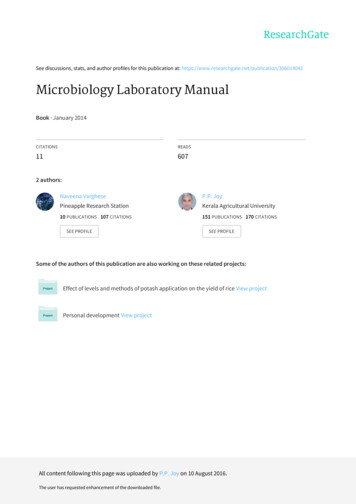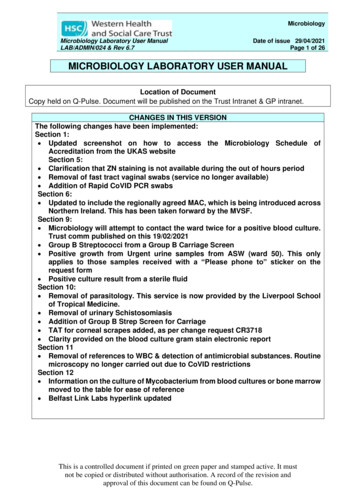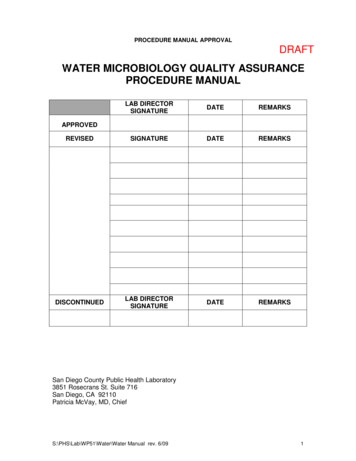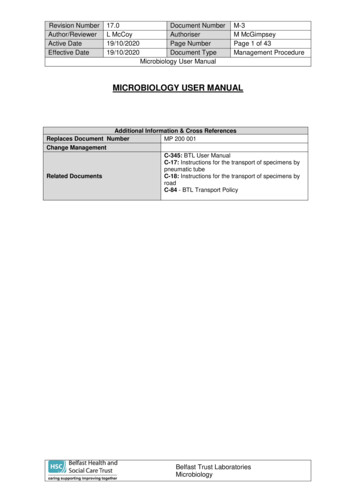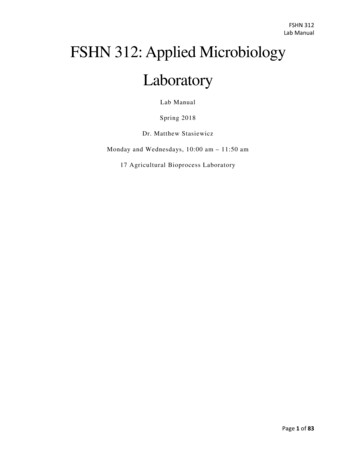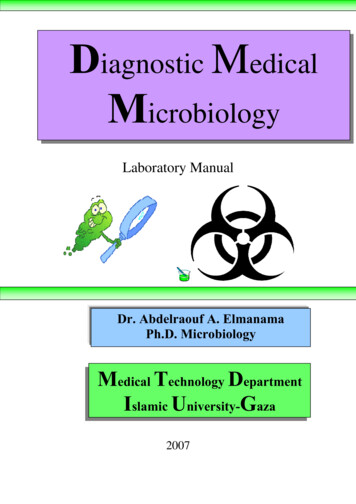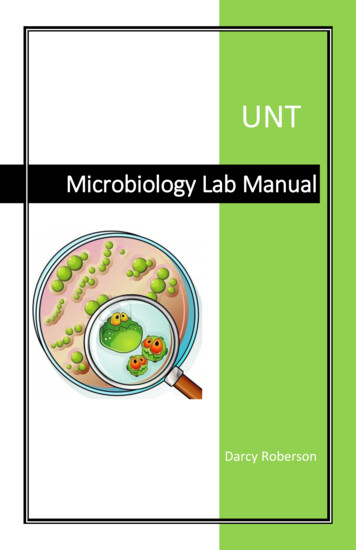
Transcription
UNTMicrobiology Lab ManualDarcy Roberson
Microbiology Lab ManualTable of ContentsTable of Contents . iiiHow to Use This Manual . vPurpose of This Manual . vWho This Manual is for . vEquipment Needed for Experiment .viOrganization of This Manual . viiLaboratory Safety . viiiChapter 1: Aseptic Technique .3What is Aseptic Technique? .3Flaming the Loop .4Keeping Lids Sterile.6Chapter 2: Starting Off the Experiment . 11Washing your hands . 11Cleaning off your lab bench . 13Organizing your supplies . 14Chapter 3: Performing a 4-Quadrant Streak forIsolation of E. coli. 17Purpose of 4-Quadrant Streak . 17Part 1: Picking a Colony . 18Part 2: Streaking the Plate for Isolation . 21Incubation . 25iii
Table of ContentsIndex . 27Citations. 29iv
Microbiology Lab ManualHow to Use This ManualPurpose of This ManualThis lab manual explains what aseptic technique is,how to prepare a lab station, and how to perform afour-quadrant streak of the bacterium Escherichia coli(E. coli) while avoiding contamination. Students willbecome experts on what a four-quadrant streak is,when to perform one, and how to avoidcontamination while using this technique.Who This Manual is forThis manual is for students at the University of NorthTexas who have completed BIOL 1730 & 1740 orBIOL 1755 and are currently enrolled in BIOL 2041 &2042. These students are familiar with using a Bunsenburner and know the characteristics of bacteria.v
How to Use This ManualEquipment Needed for ExperimentThe following laboratory equipment is necessary toperform a four-quadrant streak of bacteria for thepurpose of isolation.Wire inoculating loopFigure 1Bunsen burnerFigure 2Striker forBunsen burnerFigure 3vi
Microbiology Lab ManualPlate of E. coliFigure 4TSA plateFigure 5Organization of This ManualThis manual includes the following: Chapter 1: “Aseptic Technique” Chapter 2: “Starting Off the Experiment” Chapter 3: “Performing a 4-Quadrant Streakfor Isolation of E. coli Index Citationsvii
How to Use This ManualLaboratory SafetyFollow these guidelines to create a safe learningenvironment for you and your fellow students.Disregarding these guidelines will endanger yourhealth and the health of others in the laboratory. Wear goggles or safety glasses Tie back long hair Wear closed toe shoes Eating, drinking, or touching contact lenses inlab is prohibited Wash hands before and after completing yourlaboratory work Wipe down lab bench with disinfectant beforeand after each lab to minimize bacterialcontamination Place agar plates and othercontaminated material inBiohazard trash containerso The biohazard trashcanswill be labeled with this symbol Aseptic Bunsen burners are afire hazardo When there is a potentialfire hazard this symbolwill be presentviii
Chapter 1: Aseptic Technique
Microbiology Lab ManualChapter 1: AsepticTechniqueWhat is Aseptic Technique?Aseptic technique is a combination of laboratorymethods that keep the worker and work area free ofcontamination. It also insures culture media containonly the bacterium you are studying. Strategies thatkeep the experiment aseptic include flaming theinoculating loop and keeping the lid sterile.Figure 6: Student demonstratingaseptic technique3
Chapter 1Flaming the LoopFlaming the loop sterilizes it, ensuring that you areinoculating only the bacterium of interest.1. Hold loop in flame of Bunsen burner at a65 angleFigure 7: Flaming the loop2. Heat until red-hot for 3-5 secondsFigure 8: Red-hot loop4
Microbiology Lab Manual3. Cool loop in sterile field around flame for afew secondsFigure 9: Sterile field4. Stick loop in agar before picking a colony fromthe plateo The loop usually makes a sizzling soundFigure 10: Cooling loop in agar5
Chapter 1Keeping Lids SterileWhen performing a four-quadrant streak, follow theserules to keep from contaminating the plate: Place TSA plate in sterile field around flame ofthe Bunsen burnerFigure 11: Convection current Take lid off by grabbing the sides and liftingdirectly upwardFigure 12: Lifting up lid6
Microbiology Lab Manual Keep the lid close to plate and in the sterile fieldat all times Do not flip the lid upside down at any timeo This allows particles from above theflame to get into the lid and contaminatethe experiment.Figure 13: Plate contamination7
Chapter 2: Starting Off theExperiment
Microbiology Lab ManualChapter 2: Starting Off theExperimentWashing your hands1. Wet hands with warm water and applyantibacterial soapFigure 14: Antibacterial soap2. Scrub hands for 20-30 secondsFigure 15: Scrubbing hands11
3. Rinse hands well with waterFigure 16: Rinsing hands4. Dry hands with unused paper towelFigure 17: Drying handswith paper towel12Chapter 2
Microbiology Lab ManualCleaning off your lab bench1. Wipe entire lab table with Lysol disinfectant wipesFigure 18: Lysol wipes2. Wait 30 seconds to a minute for table to dry13
Chapter 2Organizing your supplies1. Place Bunsen burner directly in front of youo Make sure it is connected to the gas lineFigure 19: Gas line connectedto Bunsen burner2. Place striker beside Bunsen burner3. Place inoculating loop within arm’s reach4. Move E. coli plate and TSA plate to sterile fieldbeneath flame14
Chapter 3: Performing a4-Quadrant Streak forIsolation of E. coli
Microbiology Lab ManualChapter 3: Performing a 4Quadrant Streak forIsolation of E. coliPurpose of 4-Quadrant StreakThe purpose of performing a 4-quadrant streak is toisolate pure colonies of bacteria.Figure 20: Isolated colonies onplate17
Chapter 3Part 1: Picking a Colony1. Divide TSA plate into four quadrantsFigure 21: Labeled TSAplate2. Sterilize and cool loopFigure 22: Sterilizingloop18
Microbiology Lab Manual3. Remove lid from E. colio Hint: Using non-dominant hand toremove lid is most effectiveFigure 23: Removing lid4. Cool loop in agarFigure 24: Cooling loop19
Chapter 35. Pick isolated colony on plate with loopo Hint: More isolated colonies tend to bemore pureFigure 25: Isolated colonies6. Close lid and replace with TSA plate20
Microbiology Lab ManualPart 2: Streaking the Plate for Isolation1. Place TSA plate on rackFigure 26: Rack andplate2. Remove lid with thumb and middle fingerFigure 27:21
Chapter 33. Streak quadrant 1 on TSA plateFigure 28: Quadrant 14. Put lid of plate back on5. Sterilize and cool loop22
Microbiology Lab Manual6. Streak quadrant 2 on TSA plateFigure 29: Quadrant 27. Repeat steps 3 & 48. Streak quadrant 3 on TSA plateFigure 30: Quadrant 323
9. Repeat steps 3 & 410. Streak quadrant 4 on TSA plateFigure 31: Quadrant 411. Repeat step 412. Incubate plate at 37 CFigure 32: Incubation24Chapter 3
Microbiology Lab ManualIncubationIncubation is a very important part of developingpure, isolated colonies. Store the E. coli plate in anenvironment that is 37 C and check after 24 hours. Ifthe bacterium does not develop colonies in the agar bythis time, wait another 24 hours and check on the plate.25
Microbiology Lab ManualIndexAseptic, 3, 4, 5, 3Bunsen burner, 1, 2, 4,6, 14Colony, 20E. coli, 1, 3, 14, 15, 17,19, 25Four-quadrant streak,1, 2, 6Loop, 2, 3, 4, 5, 14, 18,19, 20, 22Plate, 3, 5, 6, 7, 14, 18,20, 21, 22, 23, 24, 25TSA, 3, 6, 14, 18, 20, 21,23, 2427
Microbiology Lab ManualCitationsHughes, Roxana B., and Lee E. Hughes. Microorganisms:A Laboratory Manual. Second ed. Dubuque:Kendall Hunt, 2013. Print.McGee, Matt. "Google Images." Google Images. Google,n.d. Web. 24 Nov. 2013.29
Microbiology Lab Manual v How to Use This Manual Purpose of This Manual This lab manual explains what aseptic technique is, how to prepare a lab station, and how to perform a four-quadrant streak of the bacterium Escherichia coli (E. coli) while avoiding contamination. Studen

